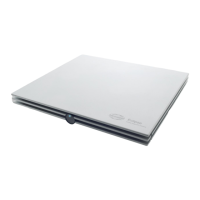Eclipse Additional Information Page 129
6.2.3 SNR in ASSR
In order to extract the evoked activity from the electrical background noise, which are picked up by the elec-
trodes, averaging is applied. This can be carried out in the temporal domain as well as in the spectral do-
main.
Temporal averaging is well known from the recording of evoked responses, where ‘sweeps’ of activity that
are time locked to the stimulus are averaged. The background noise, which appears random (i.e. not time
locked), will be cancelled out and the noise amplitude thus decreases by the square root of the number of
sweeps that are averaged. The response-to-background noise ratio (or signal-to-noise ratio, SNR) will thus
be improved.
Spectral averaging (or improvement of the SNR) can also be applied when series of relatively long se-
quences of the electrophysiological activity are submitted to a spectral analysis (often carried out by an FFT
= fast Fourier transform). The SNR-improvement is performed by narrow band filtering because the FFT can
be seen as a bank of band-pass filters where each filter has a specific center frequency and bandwidth.
The ASSR will have components at frequencies that correspond to multiples (harmonics) of the repetition
rate whereas the background noise will have components at all frequencies. Thus the longer the time se-
quence the higher the spectral resolution and the better the SNR i.e. the higher the ratio between the ampli-
tude of the frequencies that contain ASSR-information and those that only contain background noise.
The principle of detecting the presence of an ASSR in the frequency domain will optimally utilize the ampli-
tude and phase information from 12 harmonics. For increasing recording time the accumulated amplitude
and phase values (or combined into a vector) will demonstrate a small variance for each of the harmonic fre-
quencies. However, for all other frequencies which contain noise only, a random distribution of the spectral
values will be present corresponding to a large variance. These differences between the harmonic frequen-
cies and all other frequencies can be used to detect the presence of the ASSR based on statistical grounds.
Testing multiple frequencies simultaneously
By allowing different repetitions rates for different frequency specific stimuli, simultaneous stimulation can be
applied. This is possible when the physiological response is analysed in the spectral domain. The application
of multiple, simultaneous stimuli may significantly reduce test time when the ASSR is used for audiometric
evaluation. However, when simultaneous stimulation is applied masking and interaction between the stimuli
will take place and under some conditions this may affect the efficiency and accuracy of this approach.
Grounded on the same arguments as above, simultaneous stimulation on the right and left ear is also possi-
ble. However, masking and interaction between the stimuli is much more limited than in the case with simul-
taneous stimuli on the same ear.

